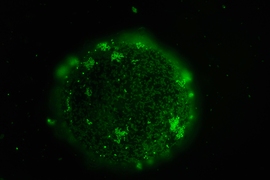When Mark Twain famously said “If you don’t like the weather in New England, just wait a few minutes,” he probably didn’t anticipate MIT researchers would apply his remark to their microbial research. But a new study does just that.
A team from MIT, using water samples from the New England coast, found that microbial communities are able to form despite rapidly varying conditions in the coastal environment. Biological communities are typically defined as the set of organisms living and interacting in a certain area, carrying out important ecological functions, such as all the organisms in a forest. In the ocean, however, water is constantly moving, making it more difficult to answer the question of what constitutes a community.
Using novel analytical techniques, the MIT researchers show that communities of interacting microbes form but are short-lived. They reach their peak abundance after only a few days and are subsequently replaced by another community. Following the forest analogy, imagine returning after a week and finding entirely different species of plants and animals populating the same area.
This rapid turnover struck the researchers as similar to Twain’s quote: “The good news may be that if you don’t like the microbial community, just wait for a few days,” they quip at the conclusion of their paper, published in Nature Communications.
“We know relatively little about how microbial communities — the assemblage of microbes in the ocean — change over time and space,” says Martin Polz, professor of civil and environmental engineering (CEE) at MIT and corresponding author on the paper. “People have gone out and taken samples in distinct locations, so we are getting to know more about the global diversity, but when you go to a particular location and ask, ‘How is it changing over time?’ we actually know relatively little.”
To fill this void, Polz and the research team collected daily ocean water samples from Canoe Cove in Nahant, Massachusetts, over a three-month period.
Together, the researchers, including graduate student Brian Cleary of the Broad Institute and MIT's computational and systems biology program; former CEE postdoc Antonio Martin-Platero; CEE postdoc Kathryn Kauffman; former CEE postdoc Sarah Preheim; Eric Alm, professor of civil and environmental engineering and biological engineering; Polz; and Dennis McGillicuddy of the Woods Hole Oceanographic Institution analyzed the samples.
In their analysis the researchers took into account temporal and spatial aspects of water movement, such as from ocean currents. The research was conducted between the summer and fall seasons, and, contrary to what may be expected, the team found that the community formation doesn’t necessarily change as a result of seasonal transitions, but rather follows the every-few-days routine. This is not to say that seasonal changes don’t influence the formation of communities, though.
“Temperature alone is a huge factor in structuring communities, but it’s not enough to go and sample once per season to have an idea of what’s going on in the season,” says Polz. “The community turnover is much faster than that, and this indicates that the ecological conditions are shifting on equally fast time scales since the organisms respond to physical and chemical changes.”
That the abundance of specific microbes in the community drops sharply after only a few days signals that they may be competing with other microbes for resources to survive. This suggests that while chemistry and physics govern overall community turnover, within communities biological interactions cause even more rapid fluctuations in species abundances.
“We think the [rapid community changes] are basically set by the ocean physics. We analyzed chemical and physical data and for some of these events we could identify a characteristic period of upwelling, when nutrient rich deep water is transported to the surface and stimulate a certain set of microbes,” says Polz. “We also looked at satellite data, which measures temperature and chlorophyll, and we saw that features developing in the ocean are corresponding with these communities. The physics really sets the chemical and temperature regimes that trigger the blooms of these communities but physical changes probably also terminate them. Because the water is constantly moving, different water bodies mix, and other local features form.”
In collaboration with Alm and his lab, the researchers also created a new algorithm to analyze the samples and sequence the genes to get a more complete understanding of the patterns and behavior of the microbial communities. Using the algorithm, Cleary explains, the researchers looked for relationships between microbes based on how they are fluctuating throughout the time series.
“There are microbes fluctuating around in an environment, but we obviously are not directly observing either the cooperative or competitive interactions between pairs [of microbes], and we aren’t directly observing the low-frequency changes that might correspond to a nutrient regime,” says Cleary. “With our algorithm, we can infer the entire community structure from these fluctuations at different frequency levels.”
The researchers’ findings also provide insight into the conditions that more permanent organisms in the region face as the microbial plankton turnover. A comprehensive understanding of microbial behavior in the ocean can inform human health, fisheries, and aquaculture, specifically through monitoring water quality.
“This paper represents a significant advance in our knowledge of the forces that mediate community assembly in fluid environments, and provides a wealth of new information to support new hypothesis-driven research into the specific mechanisms that underpin this complex association,” says Jack Gilbert, faculty director of the Microbiome Center at the University of Chicago, who was not involved in this work.
The research was funded in part by the National Science Foundation and the United States Department of Energy.











